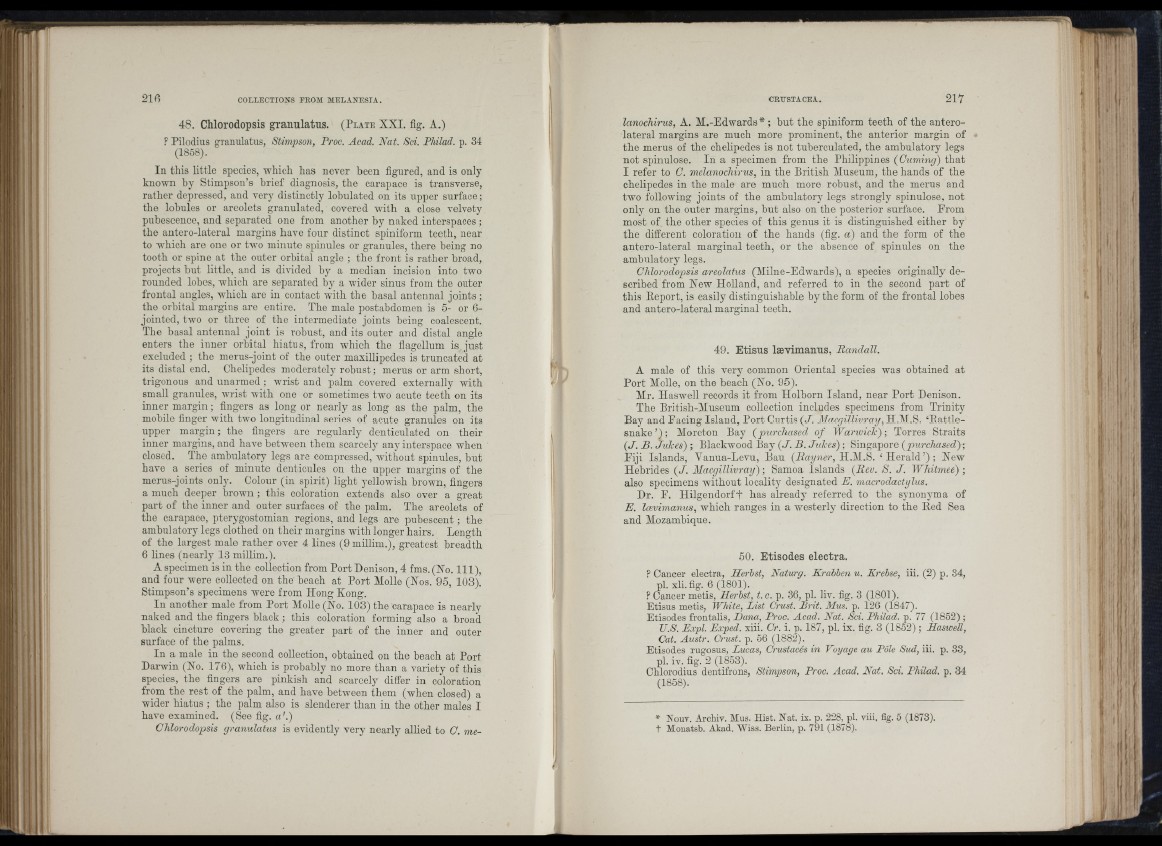
216 COLLECTIONS FROM MELANESIA.
48. Chlorodopsis granulatus. ( P l a t e XXL fig. A.)
r Pilodiiis granulatus, Stimpson, Proc. Acad. Nat. Sci. Philad. p. 34
(1858).
In this little species, which has never been figured, and is only
known by Stimpson’s brief diagnosis, the carapace is transverse,
rather depressed, and very distinctly lobulated on its upper surface;
the lobules or areolets granulated, covered with a close velvety
pubescence, and separated one from another by naked interspaces ;
the antero-lateral margins have four distinct spiniform teeth, near
to which are one or tAvo minute spinules or granules, there being no
tooth or spine at tho outer orbital angle ; the front is rather broad,
projects bnt little, and is divided by a median incision into two
rounded lobes, which are separated by a wider sinus from the outer
frontal angles, which are in contact with the basal antennal jo in ts ;
the orbital margins are entire. The male postabdomen is 5- or 6-
jointed, two or three of the intermediate joints being coalescent.
The basal antennal joint is robust, and its outer and distal angle
enters the inner orbital hiatus, from which the flagellum is just
excluded ; the merus-joint of the outer maxillipedes is truncated at
its distal end. Chelipedes moderately robust; merus or arm short,
trigonous and unarmed ; wrist and palm covered externally with
small granules, Avrist with one or sometimes two acute teeth on its
inner m arg in ; fingers as long or nearly as long as the palm, the
mobile finger with two longitudinal series of acute grannies on its
upper margin; the fingers arc regularly denticulated on their
inner margins, and have between them scarcely any interspace when
closed. The ambulatory legs are compressed, wnthout spinules, but
have a series of minnte denticnles on the upper margins of the
merus-joints only. Colour (in spirit) light yellowish brown, fingers
a much deeper broAAm ; this coloration extends also over a great
part of the inner and outer surfaces of the palm. The areolets of
the carapace, pterygostomian regions, and legs are pubescent; the
ambulatory legs clothed on their margins with longer hairs. Length
of the largest male rather over 4 lines (9 millim.), greatest breadth
6 hues (nearly 13 millim.).
A specimen is in the collection from Port Denison, 4 fms. (No. I l l ) ,
and four were collected on the beach at Port Molle (Nos. 95, 103).
Stimpson’s specimens were from Hong Kong.
In another male from Port Alolle (No. 103) the carapace is nearly
naked and the fingers b lack; this coloration forming also a broad
black cincture covering the greater part of the inner and outer
surface of the palms.
In a male in the second collection, ohtained on the beach at Port
Darwin (No. 176), which is probably no more than a variety of this
species, the fingers are pinkish and scarcely differ in coloration
from the rest of the palm, and have between them (when closed) a
wider hiatus ; the palm also is slenderer than in the other males I
have examined. (See fig. a'.)
Chlorodopsis granidatus is evidently very nearly allied to C. me-
If?
CRUSTACEA. 217
lanochirus, A. M.-Edwards*; hut the spiniform teeth of the anterolateral
margins are much more prominent, the anterior margin of
the merus of the chelipedes is not tuberculated, the ambulatory legs
not spinulose. In a specimen from the Philippines (Cuming) th at
I refer to 0. melanochirus, in the British Aluseum, the hands of the
chelipedes in the male are much more robust, and the merus and
two following joints of the ambulatory legs strongly spinulose, not
only on the outer margins, hut also on the posterior surface. Erom
most of the other species of this genus it is distinguished either by
the different coloration of the hands (fig. a) and the form of the
antero-lateral marginal teeth, or the absence of spinules on the
ambulatory legs.
Chlorodopsis areolatus (Alilne-Edwards), a species originally described
from New HoUand, and referred to in the second part of
this Keport, is easily distinguishable by the form of the frontal lobes
and antero-lateral marginal teeth.
« M'I l .i
4 i
('
49. Etisus lævimaniis, Randall.
A male of this very common Oriental species was obtained at
Port Alolle, on the beach (No. 95).
Mr. Haswell records it from Holborn Island, near Port Denison.
The British-Aluseum collection includes specimens from Trinity
Bay and Pacing Island, Port Curtis (J. Alacgillivray, H.M.S. ‘Eattle-
sn ak e’); Aloreton Bay (purchased of Wanvick); Torres Straits
(J. B. Jukes) ; Blackwood Bay (J. B. Jukes) ; Singapore (qiurchased);
Eiji Islands, Vanua-Levu, Ban (ifayner, H.Al.S. ‘ H e ra ld ’) ; N cav
Hebrides (J. Alacgillivray) ; Samoa Islands (Bev. S. J. Whitmee) ;
also specimens Avithout locality designated E. macrodactylus.
Dr. E. H ilg en d o rft has already referred to the synonyma of
E. loevimanus, which ranges in a westerly direction to the Eed Sea
and Alozamhique.
50. Etisodes electra.
? Cancer electra, Herhst, Naturg. Krahhen u. Krehse, iii. (2) p. 34,
pi. xli. fig. 6 (1801 ).
? Cancer metis, Herhst, t. c. p. 36, pi. liv. fig. 3 (1801 ).
Etisus metis. White, List Crust. Brit. Mus. p. 126 (1847).
Etisodes frontalis, Dana, Proc. Acad. Nat. Sd. Philad. p. 77 (1852) ;
U.S. Eipl. E.vped. xiii. Or. i. p. 187, pi. ix. fig. 3 (1852) ; Haswell,
Cat. Austr. Crust, p. 56 (1882).
Etisodes rugosus, Lucas, Crustacés in Voyage au Pôle Sud, iii. p. 33,
pi. iv. fig. 2 (1853).
Chlorodius dentifrons, Stimpson, Proc. Acad. Nat. Sci. Philad. p. 34
(1858).
* Nouv. Archiv. Mus. Hist. Nat. ix. p. 228, pi. viii. fig. 6 (1873).
t Monatsb. Akad. Wiss. Berlin, p. 791 (1878).